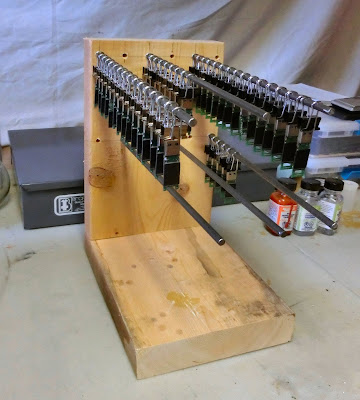How well are the read/write times in comparison to market stock times? I have a SanDisk, but for the life of me they don't post read times, and it slows down in the middle of large projects. ... When it gets hot my progress slows down by a whole addition hour.An interesting question that I didn't have the exact answer to. I've done a lot of basic, short-term speed testing and a couple of very long (weeks) burn-in tests for error checking, but no tests to see if the USB speed varied over a long term or to measure how hot the VIUD gets.
Testing
The basic setup was to just continually write to a VIUD over a period of about a day (continually copy a 4GB file to the drive) and do a couple of speed tests over that period to see if there was any variation. The continuous writing to the drive was paused while the speed tests were performed.Since the original question may be related to drive temperature I also measured the temperature of the case. The tests were done for both an Aluminum (32GB) and Titanium (256GB) drive.
Results
Results are shown the below tables.| Time | Case Temp | Read Speed | Write Speed |
|---|---|---|---|
0 hr
|
23°C
|
155.4 MB/s
|
98.1 MB/s
|
0.5 hr
|
27°C
|
||
2.5 hrs
|
33°C
|
||
5.7 hrs
|
35°C
|
||
8.5 hrs
|
37°C
|
157.0 MB/s
|
89.2 MB/s
|
21.3 hrs
|
37°C
|
156.8 MB/s
|
89.3 MB/s
|
28.3 hrs
|
36°C
|
155.1 MB/s
|
87.2 MB/s
|
| Time | Case Temp | Read Speed | Write Speed |
|---|---|---|---|
0 hr
|
22°C
|
142.1 MB/s
|
28.5 MB/s
|
4.2 hrs
|
30°C
|
142.9 MB/s
|
28.6 MB/s
|
17.5 hrs
|
28°C
|
143.5 MB/s
|
28.3 MB/s
|
27.3 hrs
|
29°C
|
141.2 MB/s
|
18.1 MB/s
|
For the temperature testing the ambient temperature was around 20°C for all tests. The temperature was measured where it was the highest value on the drive which tended to be the USB connector.
I also did some quick tests on a Sandisk Extreme 16GB USB drive. Temperatures were similar to the Titanium VIUD and no speed degradation was observed.
In terms of qualitative results, the Titanium VIUD gets very warm but not uncomfortable to the touch, similar to a normal USB drive. The Aluminum VIUD gets just a little warm to the touch.
Theory
The potential reason a typical consumer USB drive might overheat and a VIUD might not can be explained by looking at the thermal conductivities of the relevant materials.| Material | Thermal Conductivity |
|---|---|
Air
|
0.025 W/mK
|
Epoxy
|
0.3 W/mK
|
Titanium
|
20 W/mK
|
Aluminum
|
205 W/mK
|
In a consumer USB drive the circuit board is surrounded by air trapped inside the case which has a very low thermal conductivity thus trapping the heat near the board and causing to it to reach a high temperature. In a VIUD drive the circuit board is surrounded by epoxy which has 10x the thermal conductivity than air which enables it to direct the heat away from the board and into the metal case and air. In addition, the VIUD drive has the USB metal connector in close contact to the metal plug which further helps conduct the heat away from the USB.
Discussion
Compared to a normal USB the Titanium VIUD reached a similar temperature on the USB metal connector (37°C). How this translates to the interior circuit board temperature is unknown...we would expect the epoxy encased VIUD to be somewhat cooler than an air encased USB but by exactly how much would require more advanced temperature modeling.The Aluminum VIUD was noticeably cooler on the USB metal connector (30°C) and would be the choice if long term reading/writing and overheating of the USB was a concern.


















